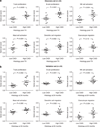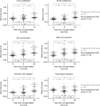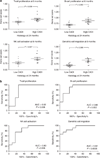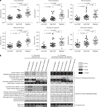Progressive histological damage in renal allografts is associated with expression of innate and adaptive immunity genes
- PMID: 21881554
- PMCID: PMC4492284
- DOI: 10.1038/ki.2011.245
Progressive histological damage in renal allografts is associated with expression of innate and adaptive immunity genes
Abstract
The degree of progressive chronic histological damage is associated with long-term renal allograft survival. In order to identify promising molecular targets for timely intervention, we examined renal allograft protocol and indication biopsies from 120 low-risk pediatric and adolescent recipients by whole-genome microarray expression profiling. In data-driven analysis, we found a highly regulated pattern of adaptive and innate immune gene expression that correlated with established or ongoing histological chronic injury, and also with development of future chronic histological damage, even in histologically pristine kidneys. Hence, histologically unrecognized immunological injury at a molecular level sets the stage for the development of chronic tissue injury, while the same molecular response is accentuated during established and worsening chronic allograft damage. Irrespective of the hypothesized immune or nonimmune trigger for chronic allograft injury, a highly orchestrated regulation of innate and adaptive immune responses was found in the graft at the molecular level. This occurred months before histologic lesions appear, and quantitatively below the diagnostic threshold of classic T-cell or antibody-mediated rejection. Thus, measurement of specific immune gene expression in protocol biopsies may be warranted to predict the development of subsequent chronic injury in histologically quiescent grafts and as a means to titrate immunosuppressive therapy.
Figures





Comment in
-
Predicting an allograft's fate.Kidney Int. 2011 Dec;80(12):1254-5. doi: 10.1038/ki.2011.328. Kidney Int. 2011. PMID: 22126981
-
The more or less 'pristine' renal allograft biopsy.Kidney Int. 2012 Jun;81(12):1277-8; author reply 1278-1279. doi: 10.1038/ki.2012.87. Kidney Int. 2012. PMID: 22648367 No abstract available.
References
-
- Yilmaz S, Tomlanovich S, Mathew T, et al. Protocol core needle biopsy and histologic Chronic Allograft Damage Index (CADI) as surrogate end point for long-term graft survival in multicenter studies. J Am Soc Nephrol. 2003;14:773–779. - PubMed
-
- Nankivell B, Richard J, Borrows R, et al. The natural history of chronic allograft nephropathy. New Engl J Med. 2003;349:2326–2333. - PubMed
-
- Nankivell BJ, Chapman JR. Chronic allograft nephropathy: current concepts and future directions. Transplantation. 2006;81:643–654. - PubMed
-
- El-Zoghby ZM, Stegall MD, Lager DJ, et al. Identifying specific causes of kidney allograft loss. Am J Transplant. 2009;9:527–535. - PubMed
-
- Ojo AO, Hanson JA, Meier-Kriesche H, et al. Survival in recipients of marginal cadaveric donor kidneys compared with other recipients and wait-listed transplant candidates. J Am Soc Nephrol. 2001;12:589–597. - PubMed
Publication types
MeSH terms
Substances
Grants and funding
LinkOut - more resources
Full Text Sources
Other Literature Sources
Medical
Molecular Biology Databases

